If we want to keep an eye on underwater environments, we already have the perfect “cameras”: sea sponges.

Sea sponges are pretty much ubiquitous in underwater environments, covering all major ocean habitats from the polar regions to the tropics. They don’t have the ability to move around, and instead filter the water flowing through them, picking out the nutritious bits (food particles). As a result, most of them prefer quiet, clear waters — sediment stirred up by waves or current can easily block their pores, rendering them unable to feed. For this reason, they are often regarded as an indicator of clean water. But they can serve as an even more important indicator, researchers have found.
As they filter huge amounts of water every single day, they also keep a chemical recording of the environment around them — kind of like the infamous CCTV (closed-circuit television) we humans use for surveillance.
“We are looking at the most efficient natural particle sampler in the ocean,” explains Professor Stefano Mariani, of the University of Salford, UK. “We want to know what’s down there, we may simply need to collect a piece of sponge and take it to the laboratory.”
Monitoring underwater life is no easy feat. The process involves scanning for (with sonar and other methods), catching, and analyzing animals, as well as using cameras, drones, and sensors. This is costly, time-consuming, and can also harm wildlife.
Previously, Mariani and colleagues described a new way to derive information about what lies under the waves: ‘DNA fishing’. Essentially, the approach relies on analyzing genetic material floating randomly in the water and identifying the source species. This is much more effective than catch-and-release techniques and is also non-invasive.
However, there are also some errors associated with this approach, and this is where sea sponges can come in handy: they can filter over 10,000 liters of water per day, and therefore come in contact with substantial amounts of floating DNA.
To test this idea, Mariani and his team examined sponges from five Antarctic locations and four in the Mediterranean, which yielded DNA from dozens of marine animals. These species can be harvested with relative ease and minimal disruption, and provide valuable proxy information at low costs.
“There is no doubt that engineering technology, submarines, robots, will play a significant part in enhancing marine exploration – but much of it remains prohibitively expensive,” says Mariani.
“Our initial findings suggest that simple, accessible natural ‘sentinels’ can be a powerful, affordable and universal means for aquatic biodiversity monitoring globally.
In 2018, the same team found that shrimps’ stomach contents can also be used for the same purpose, as they are also widespread and not particularly selective with what they eat, but this confirms that sponges are better suited for this purpose.
The study ‘Sponges as natural environmental DNA samplers’ was published in Current Biology.



